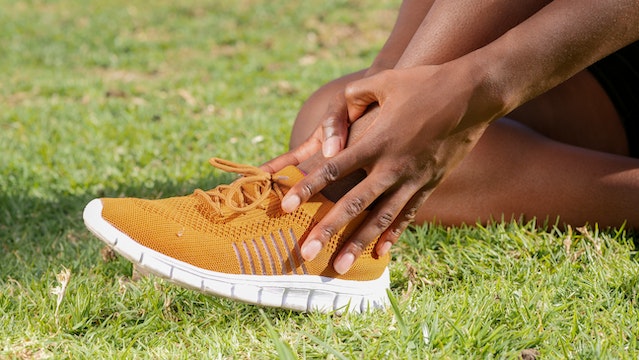Give PEACE&LOVE to your Sprained Ankle, not just Ice.
“It’s just an ankle sprain.” Is it, really?
An ankle sprain is one of the most common injuries of all time. However, just because it happens so often, does not mean that it is a minor injury. When it’s not treated properly, it can lead to Chronic Ankle Instability (CAI) which will cause constant pain and misery. This is the case for 40% of all ankle sprains, according to research. So today, we will cover the key concepts to follow to recover from an ankle sprain as efficiently as possible.
RICE is outdated. Follow PEACE AND LOVE.
The RICE (Rest, Ice, Compression, Elevation) protocol has long been the go-to technique for the public to treat ankle sprains. However, new research suggests that RICE might not be the best method. Let’s dive into why.
Rest alone is not enough
In contrast to the previous belief, simply resting and waiting for the ligaments to heal on their own is not the most efficient approach. It can slow down healing because there are not enough signals to the soft tissue to activate the regeneration process.
Instead, active recovery, meaning that you are moving the ankle in a pain-free manner, is a more effective option. Why? By contracting the muscles around the ankle, it can work as a pump and help reduce swelling. It also activates the lymphatic system, which is the natural waste-removal system in the body. Also, it promotes more blood flow to the area so that good nutrients can facilitate the inflammatory response. Inflammation itself is not necessarily a bad thing. A chronic and stagnant inflammation that doesn’t get its job done is. So we simply need to promote fast and adequate inflammation.
Ice won’t fix ankle sprain
Ice does not have a statistically meaningful healing effect on injuries. In fact, icing it too much at the early stage of the healing process can rather hinder the process. It is because ice does not allow the inflammatory chemicals to come and repair the injured site. So what do you feel better after icing it? Well, ice does slow down the nerve conduction velocity and momentarily stops the pain. In other words, the ice numbs you down while you put it on. However, unfortunately, icing alone will not fix the injury.
So what do we do instead?
In 2019, the British Journal of Sports Medicine released a new protocol ‘PEACE & LOVE‘ to manage acute soft tissue injuries.
PROTECTION
ELEVATION
AVOID ANTI-INFLAMMATORIES
COMPRESSION
EDUCATION
&
LOAD
OPTIMISM
VASCULARIZATION
EXERCISE
British Journal of Sports Medicine / LOVE AND PEACE (Dubois et al, 2019)
PEACE
The PEACE&LOVE protocol stands for Protection, Elevation, Avoid Anti-inflammatories, Compression, Education, Load, Optimism, Vascularization, and Exercise. Immediately following the injury, remember to protect the ankle with a brace or cast, and keep it elevated and compressed to limit excessive swelling. Since the ankle is the lowest point of the body, it is possible that too much swelling builds up and makes the recovery process more difficult. However, it is not recommended to take anti-inflammatory medications such as Advil or Ibuprofen (Tylenol is okay) because they will prevent the inflammation from happening from the start. Remember, as we covered above, inflammation is necessary to initiate the tissue healing process.
You are nailing on the education part if you have been following this article! You are learning new and evidence-based methods to treat your ankle.
LOVE
Once the initial swelling and pain go away, you can start moving your ankle and putting weight on it if it is not painful. You can start with a gentle weight shift exercise, putting your weight from one side to the other. Once you are comfortable with that, there are great exercises to activate the muscles around the ankle to strengthen the muscles and promote more blood flow to the area. For example, ankle pumps, ankle 4 ways exercise with the band, and foot arch exercises are good options. Ankle mobility exercises can also be indicated if your ankle is feeling stiff due to scar tissues.
You might be feeling frustrated if you’ve had countless ankle sprains in the past and it’s limiting you from doing what you love. If so, reach out to us! We are skilled physical therapists and athletic trainer who specializes in getting you back to physical activities without pain and discomfort. It is important to stay optimistic and motivated an injury to recover as efficiently as possible. By working with a professional who is an expert in guiding you through ankle rehabilitation, you will be able to return to your hobbies sooner than you think.
Start building a habit
If you roll your ankle consistently, consider starting small habits in your daily life that you can work on quick and simple ankle exercises. How about standing on one leg while you are brushing your teeth, washing the dishes, or filling up your water bottle? How about doing seated heel raise to strengthen your calf on your left side when you are stopping at the red light? Implementing these small exercises throughout your daily life is a great way to prevent ankle sprains.
Build a bulletproof ankle with us!
At Advanced Physical Therapy, we provide thorough assessment and personalized rehabilitation plans to get you back to the activities that you love. If your insurance is not covering the physical therapy session, you can sign up for Next Level Program and work with our athletic trainers. The cost will be about the same or lower than the co-pay you would pay for a physical therapy session. Contact us below and make an appointment for today.

